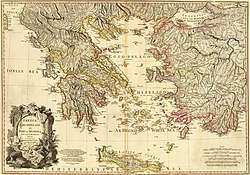Greece in the Roman era
Greece in the Roman era describes the Roman conquest of the territory of the modern nation-state of
The definitive Roman occupation of the Greek world was established after the
Roman Republic

The
In 88 BC,
As an empire, Rome invested resources and rebuilt the cities of Roman Greece, and established Corinth as the capital city of the province of Achaea, and Athens prospered as a cultural hub of philosophy, education and learned knowledge.
Early Roman Empire
| History of Greece |
|---|
 |
|
|
Life in Greece continued under the Roman Empire much the same as it had previously. Roman culture was highly influenced by the Greeks; as Horace said, Graecia capta ferum victorem cepit ("Captive Greece captured her rude conqueror").[6] The epics of Homer inspired the Aeneid of Virgil, and authors such as Seneca the Younger wrote using Greek styles. Some Roman nobles regarded the Greeks as backwards and petty, but many others embraced Greek literature and philosophy. The Greek language became a favorite of the educated and elite in Rome, such as Scipio Africanus, who tended to study philosophy and regarded Greek culture and science as an example to be followed.
The
Many temples and public buildings were built in Greece by emperors and wealthy Roman nobility, especially in Athens.
The Pax Romana was the longest period of peace in Greek history, and Greece became a major crossroads of maritime trade between Rome and the Greek speaking eastern half of the empire. The Greek language served as a lingua franca in the eastern provinces and in Italy, and many Greek intellectuals such as Galen would perform most of their work in Rome.
During this time, Greece and much of the rest of the Roman east came under the influence of
Later Roman Empire
During the 2nd and 3rd centuries, Greece was divided into provinces including
Greece faced invasions from the
Greece remained part of and became the center of the remaining relatively cohesive and robust eastern half of the Roman Empire, the
Contrary to outdated visions of
The Roman emperor Heraclius in the early 7th century changed the empire’s official language from Latin to Greek. As the eastern half of the Mediterranean has always been predominantly Greek, the eastern half of the Roman Empire gradually became Hellenized following the fall of the Latin western half. Over the course of the following centuries, mainland Greece was mainly contested between the Roman and Bulgarian Empires, and suffered from invasions by Slavic tribes and Normans. Crete and Cyprus were contested between the Romans and Arabs and were later taken by the Crusaders who, following the Sack of Constantinople in 1204, established the Latin Empire in Thrace and Greece. The Romans retook Constantinople and re-established control in most of the Greek peninsula, although Epirus would remain an independent splinter state until the early 14th century when Roman control was re-established. As a civil war raged within the empire, the Serbian Empire took the opportunity to conquer most of mainland Greece, while a resurgent Bulgarian Empire invaded from the north. In the century that followed, the Ottoman Empire would establish its dominance in the region, annexing all three empires and finishing its conquest of Greece with the fall of the Morea in 1460.
References
- OCLC 813628501.
- OCLC 972308960.
- ISBN 978-1-78076-593-8, retrieved 2021-07-11
- OCLC 1189729109.
- ^ Hellenistic Age. Encyclopædia Britannica. 2013. Retrieved 27 May 2013. Archived 14 May 2013.
- ^ "Horace – Wikiquote". en.wikiquote.org. Retrieved 2018-04-27.
- ^ a b c Rothaus, p. 10. "The question of the continuity of civic institutions and the nature of the polis in the late antique and early Byzantine world have become a vexed question, for a variety of reasons. Students of this subject continue to contend with scholars of earlier periods who adhere to a much-outdated vision of late antiquity as a decadent decline into impoverished fragmentation. The cities of late-antique Greece displayed a marked degree of continuity. Scenarios of barbarian destruction, civic decay, and manorialization simply do not fit. In fact, the city as an institution appears to have prospered in Greece during this period. It was not until the end of the 6th century (and maybe not even then) that the dissolution of the city became a problem in Greece. If the early 6th century Syndekmos of Hierocles is taken at face value, late-antique Greece was highly urbanized and contained approximately eighty cities. This extreme prosperity is born out by recent archaeological surveys in the Aegean. For late-antique Greece, a paradigm of prosperity and transformation is more accurate and useful than a paradigm of decline and fall."
Sources
- Bernhardt, Rainer (1977). "Der Status des 146 v. Chr. unterworfenen Teils Griechenlands bis zur Einrichtung der Provinz Achaia". Historia: Zeitschrift für Alte Geschichte (in German). 26 (1): 62–73. JSTOR 4435542.
- Boardman, John The Oxford History of Greece & the Hellenistic World 2nd Edition ISBN 0-19-280137-6
- Rothaus, Richard M. Corinth: The First City of Greece. Brill, 2000. ISBN 90-04-10922-6
- Francis, Jane E. and Anna Kouremenos Roman Crete: New Perspectives. Oxford: Oxbow, 2016. ISBN 978-1-78570-095-8
- Kouremenos, Anna The Province of Achaea in the 2nd Century CE: The Past Present. London and New York: Routledge, 2022. ISBN 1032014857
